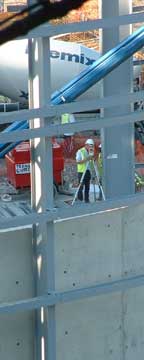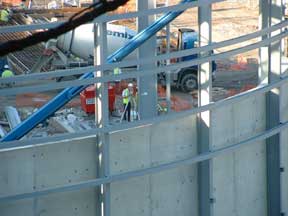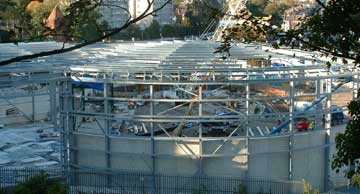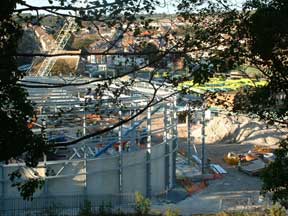This page is from the Round Hill Society archives which are available for historic interest. Please bear in mind when viewing archived pages that details may no longer be current.
Veolia 2006-the aftermath
Weekend working, the Council, Veolia and local residents

Residents in Round Hill, Hollingdean and areas on and adjoining Ditchling Road have had to put up with weekend working on the Hollingdean Depot site - a nuisance to those wanting to enjoy quiet leisure time with their families or on their own.
What have the Council got to say about it?
Senior Environmental Health Officer, Jim Whitelegg, in his letter to a resident living in Princes Road, explained the operating restrictions:
"Working hours for the main construction works are restricted to Monday – Friday 07.00 to 19.00 hours and 08.00 to 13.00 hours on Saturdays, although wherever possible noisy activities will be undertaken Monday – Friday between 08.00 hours to 18.00 hours with no working on Sundays or Bank holidays. I understand the contractors usually finish at 17.30 hours Monday to Friday."

"These hours are good practice in line with guidance taken from BS 5228 Code of Practice for controlling noise from construction sites. Within any construction site, especially large scale projects, there will be times when works will exceed these hours due to emergencies or the nature of certain activities."

"Should any emergency works or activities that can not be carried out during the hours stipulated above, 72 hours written notice shall be given to the City Council along with an agreed method of works. An example of such work that may over run would be concrete floor pouring where the concrete is poured and continually power floated until properly set. The work can only finish when the concrete is set and this is dependent on variable factors such as atmospheric conditions.
The work on Saturday morning was a concrete pour and the contractors applied for a extention till 14.00 hours. I've spoken to the contractors and unfortunately the concrete curring took longer than expected and the didn't actually finish until 16.30 hours. Normally, the floor slab pours would be carried during the week which would enable the concrete to set within the usual working hours."

What have local residents got to say?
Princes Road resident, Simon Biddell, thanked the Council's Environmental Health Officer for his statement, but added:
"personally, I still think that construction work in densely populated residential areas should not be undertaken at weekends but perhaps this is just wishful thinking"
This page was last updated by Ted on 09-May-2025

Residents in Round Hill, Hollingdean and areas on and adjoining Ditchling Road have had to put up with weekend working on the Hollingdean Depot site - a nuisance to those wanting to enjoy quiet leisure time with their families or on their own.
What have the Council got to say about it?
Senior Environmental Health Officer, Jim Whitelegg, in his letter to a resident living in Princes Road, explained the operating restrictions:
"Working hours for the main construction works are restricted to Monday – Friday 07.00 to 19.00 hours and 08.00 to 13.00 hours on Saturdays, although wherever possible noisy activities will be undertaken Monday – Friday between 08.00 hours to 18.00 hours with no working on Sundays or Bank holidays. I understand the contractors usually finish at 17.30 hours Monday to Friday."

"These hours are good practice in line with guidance taken from BS 5228 Code of Practice for controlling noise from construction sites. Within any construction site, especially large scale projects, there will be times when works will exceed these hours due to emergencies or the nature of certain activities."

"Should any emergency works or activities that can not be carried out during the hours stipulated above, 72 hours written notice shall be given to the City Council along with an agreed method of works. An example of such work that may over run would be concrete floor pouring where the concrete is poured and continually power floated until properly set. The work can only finish when the concrete is set and this is dependent on variable factors such as atmospheric conditions.
The work on Saturday morning was a concrete pour and the contractors applied for a extention till 14.00 hours. I've spoken to the contractors and unfortunately the concrete curring took longer than expected and the didn't actually finish until 16.30 hours. Normally, the floor slab pours would be carried during the week which would enable the concrete to set within the usual working hours."

What have local residents got to say?
Princes Road resident, Simon Biddell, thanked the Council's Environmental Health Officer for his statement, but added:
"personally, I still think that construction work in densely populated residential areas should not be undertaken at weekends but perhaps this is just wishful thinking"